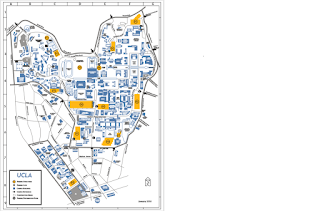Week 7 : NEUROSCIENCE & ART
Two weeks ago, we are learning about the artistic expression using medical technologies as the artists become interested in scientific knowledge. This week's lecture focuses on the fact that artists are creating new forms of art using the field of neuroscience that came to be known as people became more aware of the human body.
Professor Vesna introduced the person, called Franz Joseph Gall, a renowned phrenologist who decide the individual’s potential through the degree to which the head felt bumps on. Furthermore, he argued that the size of the brain is directly related to intelligence. Even though the old-fashioned theory of phrenology is now widely regarded to be a pseudoscience, the origins of the theory have been very helpful in studying the structure of the brain. As science advances, Brainbow has been invented which helps technically to understand the brain by illuminating nerve cells using different colors to track axons and patterns in the neurons of the brain (Litchamn).
Frazzetto and Anker mentioned "Ideas, concepts and images in neuroscience widely circulate in culture and are portrayed in literature, film, works of art, the mass media and commercial products ", suggesting that neuroscience could be used in a wider variety of fields, not just in the laboratory. Eventually, a new project called "Neurasthenics" has emerged that studies art using the method of neuroscience. Although neuroscience did not produce exciting and surprising results due to the limitations such as " neuroscience has yet to frame anything like an adequate biological or “naturalistic” account of human experience."(Noe), our interest in the brain allows the scientists and artists to discover new perspectives and increased creativity that transcends cultural boundaries, as Jung said “the fascination of the psyche brings about a new self-appraisal, a reassessment of our fundamental human nature” The interaction between art and neuroscience gives each other an opportunity to further develop.
Reference
1 - Frazzetto, Giovanni, and Suzanne Anker. "Neuroculture." Nature Reviews Science and Society: Neuroculture 10 (2009): 815-21. Print. Accessed 19 May 2018.
2 - J. Litchman "Brainbow." Brainbow | Center for Brain Science. Harvard, n.d. Accessed 18 May 2018. <http://cbs.fas.harvard.edu/science/connectome-project/brainbow#>.
3 - Jung, Carl Gustav. The Spiritual Problem of Modern Man. Mayavati: n.p., 1931. Print. Accessed 18 May 2018
4 - Vesna, Victoria. "Neuroscience-pt1.mov." YouTube. YouTube, 17 May 2012
<https://www.youtube.com/watch?&v=TzXjNbKDkYI>.
5 - Noe, Alva. "Art and the Limits of Neuroscience." The New York Times. The New York Times Company, 4 Dec. 2011.
<https://opinionator.blogs.nytimes.com/2011/12/04/art-and-the-limits-of-neuroscience/>
Imagine
Figure 1 - “Franz Joseph Gall”, Wikipedia, Accessed 20 May 2018
< https://en.wikipedia.org/wiki/Franz_Joseph_Gall#/media/File:Franz_Josef_Gall3.jpg >
Figure 2 - J. Litchman "Brainbow." Brainbow | Center for Brain Science. Harvard, n.d. Accessed 18 May 2018. <http://cbs.fas.harvard.edu/science/connectome-project/brainbow#>.
Figure 3 - Durbanova, Anna “Jeweler’s Art Meets Neuroscience”, IMPAKTER, Feb 8, 2018
< https://hkcdesigns.wordpress.com/2018/02/09/jewelers-art-meets-neuroscience/>






댓글
댓글 쓰기